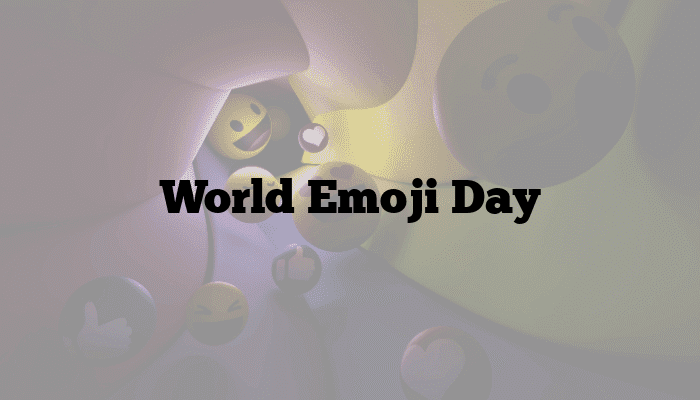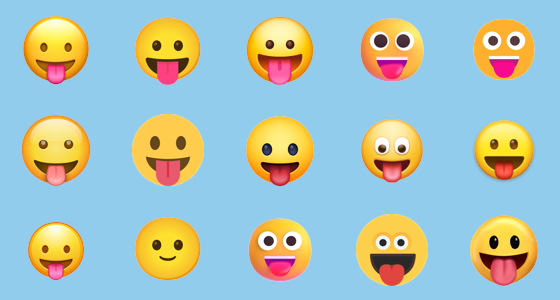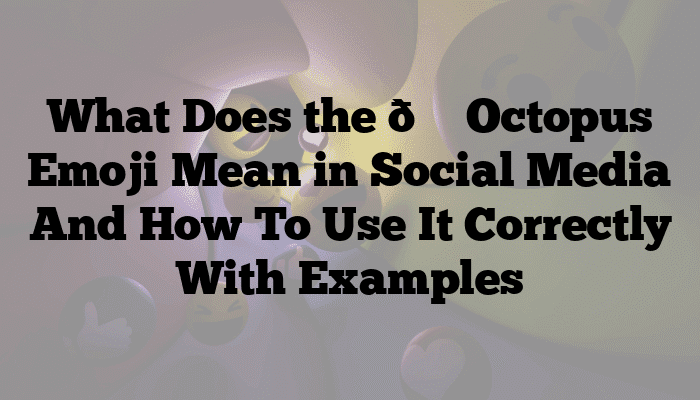World Emoji Day: Date, history, significance, celebration and statistics
Introduction to World Emoji Day
World Emoji Day is an annual celebration dedicated to the world of emojis. It is a day meant to recognize the influence of these digital characters on the way we communicate with each other. The day is celebrated widely around the world with special events, online initiatives, and social media campaigns.
History and Significance of World Emoji Day
World Emoji Day was established in 2014 by Jeremy Burge, the founder of Emojipedia. It was created to bring attention to the importance of emojis in modern digital communication. According to Burge, the day was also created to celebrate the fact that July 17th is the date that appears on the calendar emoji, which is widely used across platforms.
The use of emojis has become an integral part of modern communication. They add color, emotion, and context to otherwise dry and mundane texts. Emojis are now also used in marketing and advertising campaigns as they provide a relatable, visual language that consumers can identify with.
Date of World Emoji Day
World Emoji Day is celebrated annually on July 17th. The date is significant as it appears on the calendar emoji, which is widely used across platforms. The day is celebrated worldwide, with events, online initiatives, and social media campaigns aimed at recognizing the importance and significance of emojis in modern communication.
In conclusion, World Emoji Day is a special day dedicated to celebrating the fun, colorful, and often quirky world of emojis. It highlights the importance of emojis in modern communication and how they have become an integral part of our daily lives. With the growing use of emojis, this day will only continue to gain in importance in the coming years.
A Brief History of Emojis
Origins and evolution of emojis
Emojis are digital characters or pictograms used to express emotions, objects, and actions in a visual form. The word emoji originates from two Japanese terms: “e” meaning picture and “moji” meaning character. Emojis first emerged in Japan in the late 1990s as a way for people to convey emotions quickly and efficiently through text messages. The original set of emojis consisted of 176 designs and focused mainly on emotions, objects, and weather conditions.
The use of emojis quickly spread beyond Japan to other countries. In 2010, Apple included the first set of emojis in its iOS operating system, making them accessible to a wider global audience. With the increasing popularity of social media platforms like Facebook, Twitter, and Instagram, the use of emojis also exploded, with new designs being added each year.
Impact of emojis on digital communication
Emojis have become an integral part of modern communication. They provide a way to add color, emotion, and context to otherwise plain and emotionless texts. In addition to personal use, emojis are also used in marketing and advertising campaigns to create a relatable and visual language that connects with consumers.
The impact of emojis is evident in modern digital language, with the Oxford English Dictionary officially recognizing the “Face with Tears of Joy” emoji as the Word of the Year in 2015. Emojis have also been used to break down language barriers, with some social media platforms like Twitter and Facebook creating universal designs to make communication between users easier.
In conclusion, emojis have come a long way since their origin in Japan in the late 1990s. Today, they are an integral part of modern digital communication and are widely recognized as an important aspect of language and culture. With new designs being added each year, emojis will undoubtedly continue to shape the way we communicate in the digital age.
The Cultural Significance of Emojis
Role of emojis in shaping culture and language
Emojis have transcended their original purpose as a means of expressing emotions in digital communication. They have influenced and shaped modern communication culture, by providing a new visual language and introducing new ways of expression. Emojis can help people feel understood, and can foster a sense of community and shared values through their use.
The evolution of emojis, from the original set of 176 designs to the thousands available today, is a sign of their cultural significance. In Japan, emojis have become a part of daily communication, and the country even has an annual World Emoji Day celebration. Similarly, emojis have been embraced around the world as a means of expression that transcends language barriers and reaches a wide audience.
Emojis as a tool for inclusivity and representation
Emojis also have the power to promote inclusivity, break down stereotypes, and foster diversity. In 2015, Apple released a set of racially diverse emojis, representing different skin tones, which was an important step in addressing the issue of representation in digital communication. Similarly, the addition of emojis representing people with disabilities, same-sex couples, and gender inclusivity has helped to create a more inclusive and diverse visual language.
Emojis have also been used to promote social issues and causes, from the “I Voted” emoji to raise awareness about elections to the “Rainbow” emoji to celebrate Pride Month. By providing a visual symbol for ideas and emotions, emojis have become a powerful tool for activism and advocacy.
In conclusion, the cultural significance of emojis cannot be underestimated. Emojis have played an important role in shaping modern communication culture, promoting inclusivity and diversity, and even advocating for social issues. As new designs continue to emerge, emojis offer endless possibilities for expression and creativity in digital communication.
The Cultural Significance of Emojis
Emojis have transitioned from a simple means of expressing emotions in digital communication to a tool that shapes modern communication culture. They have introduced new ways of expression, fostering a sense of community and shared values. With thousands of emojis available today, their evolution reflects their cultural significance across the world, particularly in Japan, where emojis are a part of daily communication.
Role of Emojis in shaping Culture and Language
Emojis are influential in shaping culture and language, enabling people to feel understood by providing a visual language. The diversity of its use creates endless possibilities for expression and creativity in digital communication while breaking down language barriers and reaching a wide audience.
Emojis as a tool for inclusivity and representation
Emojis promote inclusivity and diversity. The representation of different skin tones in Apple’s set of racially diverse emojis, the addition of same-sex couples, and gender inclusivity has helped create a more inclusive and diverse visual language. Emojis have become a powerful tool for activism and advocacy, with the “I Voted” emoji and “Rainbow” emoji for Pride Month.
World Emoji Day Celebration
On July 17th, people worldwide celebrate World Emoji Day. The aim is to appreciate their use, value, and impact on contemporary communication culture.
Activities and Events
The events and activities on World Emoji Day celebrate how emojis have transformed communication, with events such as emoji-themed parties or festivals, public lectures, and exhibits. People also engage in social media challenges or create new designs to commemorate the day.
Partners for World Emoji Day Celebration
The day is supported by Apple, Google, and other tech companies that have helped the growth and promotion of emojis. The World Emoji Day’s website also partners with organizations that use emojis as a tool for advocacy and awareness.
In conclusion, emojis have taken an essential place in people’s lives worldwide, shaping modern communication culture, representation, and inclusivity. As they continue to evolve, emojis’ possibilities and their cultural significance remain endless.
Brands and Emojis
Significance of Emojis for Brands
Emojis have become a crucial part of digital marketing, with brands using them to communicate with their audiences in a more personalized and relatable way. Brands that use emojis in their social media marketing campaigns tend to have higher engagement rates than those that don’t.
Emojis are an effective way to convey a brand’s personality and emotions, creating a strong brand identity. They also help make advertising more memorable and fun, promoting brand awareness and boosting audience’s emotional engagement.
How Brands celebrated World Emoji Day?
On World Emoji Day, many brands joined the celebration by creating creative and fun campaigns and social media posts. Many companies launched limited-edition emoji-themed products, and others offered themed discounts and giveaways.
For example, Pepsi released a new set of proprietary emojis for its customers. Google celebrated the day with a blog post detailing the ongoing evolution of emojis, while Twitter created a hashtag, #WorldEmojiDay, for users to share how they were using emojis to celebrate the occasion.
The significance of emojis for brands is continually evolving, with more companies integrating them into their advertising strategies as a means of creating more engaging content and building better emotional connections with audiences.
Emojis and Social Media
Impact of Emojis on Social Media
Brands have greatly exploited emojis as part of their digital marketing strategy to humanize and connect with their target audience on social media. Emojis convey a wide range of emotions, making brands’ communication with their audience more personal, relatable, and casual. They create an emotional connection that enables brands to establish a unique personality and stand out in the crowded social media space.
Studies have shown that compared to text-only posts, social media posts that include emojis get more user engagement. Emojis increase the probability of a post being clicked, shared, or liked, making them a crucial tool for building brand awareness and fostering emotional connections with social media users.
Most Used Emojis
According to research, the most used emojis vary from platform to platform. On Twitter, the most used emoji is the face with tears of joy, followed by the red heart and the smiling face with heart eyes. On Instagram, the heart emoji is the most popular, followed by the heart-eyed face and the face with tears of joy.
Despite these variations, emojis that relate to common human emotions like love, joy, laughter, and humor are always the most used and appreciated. Brands that can cleverly integrate these emotions into their emoji-based social media content stand a good chance of engaging and retaining their followers.
In conclusion, emojis are an integral part of social media marketing, and brands can take advantage of them to effectively connect and build better emotional bonds with their target audience. By integrating the most commonly used emojis into their content and using them to convey emotions and personality, brands can significantly increase engagement rates and build long-term brand loyalty.
World Emoji Day Statistics
Important Statistics about Emojis
Brands use emojis in their digital marketing strategies to establish an emotional connection with their audience. Emojis can convey a wide range of emotions, making brand communication with followers more personal. Studies show that social media posts including emojis get higher engagement than text-only posts.
Emojis have become an integral part of social media, with over 5 billion emojis sent daily on Facebook Messenger alone. An estimated 92% of the online population use emojis, with those under 25 using them the most.
Usage of Emojis around the Globe
A survey showed that users in different countries have their own preferences for certain emojis. For example, the heart emoji is the most popular in France, while the thumbs up emoji is most commonly used in the US.
The face with tears of joy emoji is one of the most popular globally, and was chosen as the Oxford Dictionary’s Word of the Year in 2015. It is even more popular in the UK, where it was used over 2,000 times in the House of Commons’ official Twitter account in 2015.
In conclusion, emojis have become a universal language, with their usage extending beyond social media to messaging applications, email, and even professional communications. Brands that incorporate emojis into their marketing strategies can effectively engage with their followers and establish a unique brand personality.
Future of Emojis
Research and Development for Emojis
Emojis have come a long way since their inception in the late 1990s, evolving from a simple set of smileys and symbols to a complex ecosystem with over 3,000 emojis available today.
With the increasing usage of emojis, companies are investing heavily in research and development to create more emoji options and improve their design. For instance, Apple’s Animojis and Memojis use facial recognition technology to enable users to create animated characters that reflect their facial expressions.
Additionally, researchers are exploring ways to incorporate cultural diversity into emojis. The Unicode Consortium, which manages the global standard for emoji, has developed a new skin tone modifier to enhance the representation of different skin colors in emojis.
New Emojis in 2024
Every year, the Unicode Consortium releases new emojis to keep up with the ever-growing demand for more diverse and expressive symbols. In 2021, several new emojis are slated for release, including:
- A heart on fire
- A face with spiral eyes (to represent dizziness)
- A woman with a beard
- A person with a crown
- A person with a beard and goggles
These new emojis aim to cater to diverse cultures, genders, and expressions, making them more inclusive and representative of the world we live in.
In conclusion, emojis will most likely continue to play a vital role in communication and digital marketing. As companies continue to invest in research and development, users can expect more diverse and expressive emojis that cater to their needs.
Future of Emojis
Research and Development for Emojis
Emojis are now a ubiquitous part of digital communication, and their usage is only growing. With this in mind, companies are investing heavily in research and development to create more comprehensive and expressive options for the ever-demanding users. Apple’s Animojis and Memojis use facial recognition technology to enable users to create animated characters that reflect their facial expressions. The Unicode Consortium, which manages the global standard for emojis, is exploring ways to incorporate cultural diversity into emojis. Researchers have developed a new skin tone modifier that will enhance the representation of different skin colors in emojis.
New Emojis in 2024
Every year, the Unicode Consortium releases new emojis to cater to a more diverse audience. The upcoming release of new emojis in 2021 includes options such as a heart on fire, a face with spiral eyes (to represent dizziness), a woman with a beard, and a person with a crown. All these new emojis aim to cater to diverse cultures, genders, and expressions, making them more inclusive and representative of the world we live in.
Wrapping up World Emoji Day
World Emoji Day is an excellent opportunity to celebrate their role in global communication and marketing. Emojis have evolved from simple smileys and symbols to an extensive ecosystem with over 3000 emojis available today that cater to the needs of modern digital communication.
Future of emojis and how they would shape digital communication
The usage of emojis is on the rise, and they will continue to play a vital role in communication and digital marketing. It is evident that emojis are becoming more diverse and inclusive, catering to various cultures and expressions. As companies invest in research and development to create new emojis, it is safe to say that emojis’ future looks vibrant and exciting.




